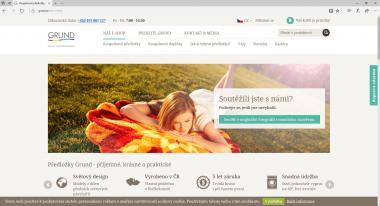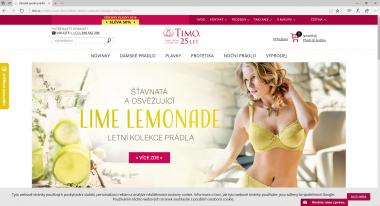CZECH TEXTILE INDUSTRY CONTINUES ITS UPSWING
- Sales are increasing since four years
- Developing of up new markets abroad
Prague (GTAI) - Czech textile and clothing manufacturers are among the winners of the good economic situation. The trend towards domestic products and the rising purchasing power are inspiring the companies. At the same time they benefit from a growing demand from abroad. According to the association ATOK the turnover of the sector rose to Kc 53,5 billion (just under EUR 2 billion) in 2016. It was the fourth year of growth in a row.
An important growth driver of the Czech textile industry is the automotive sector. The largest sales are achieved with technical textiles, and these are mostly used in the over 1.3 million passenger cars, which are rolling in the Czech Republic off the assembly lines every year. The German automotive supplier Borgers is therefore the second largest textile manufacturer in the country. The company produces textile trims for trunks, passenger compartments or underfloor at four locations in the Plzen region. About 200,000 parts leave the factory every day for VW, BMW, Mercedes, Porsche, Bentley and Rolls Royce. The largest textile company in 2016 was the company Juta with productions of geotextiles, insulation materials and packaging material.
The positive dynamism of textile manufacturers is continuing in 2017. According to statistics from January to May the production index rose by 3% and the value of new orders even rose by 5%. On the other hand the garment manufacturers have to announce sales reductions following the strong year before. Future growth could be curbed by rising wages, the appreciation of the national currency and a lack of staff.
| Year | Sales in Mrd. Kc | .thereof textiles in Kc bn. | .thereof Clothing in Kc bn. | Change total sales in comparison to previous year in % |
|---|---|---|---|---|
| 2013 | 47.1 | 40.7 | 6.4 | 2.6 |
| 2014 | 51.0 | 44.6 | 6.4 | 8.3 |
| 2015 | 52.4 | 45.4 | 7.0 | 2.7 |
| 2016 | 53.5 | 46.2 | 7.3 | 2.1 |
Sources: Association of the Textile, Garment and Leather Industry (ATOK), Calculations by Germany Trade & Invest
Even more dynamically than the sector's profits the foreign trade has developed in 2016. Since the Czech Republic is being used as a transit and logistics location by international trading companies, the volume of exports is significantly higher than the total turnover of the domestic manufacturers. According to the ATOK association, in 2016 textiles were exported for Kc 63.8 billion (EUR 2.36 billion) and clothing for Kc 47.2 billion (EUR 1.74 billion). This was an increase of 5% for textiles and 31% for clothing. Import of textiles rose by 6% to Ks 59.3 billion (EUR 2.19 billion), import of garment rose by 20% to Kc 67.9 billion (EUR 2.51 billion).
This has somewhat reduced the trade deficit in clothing. In the major fashion chains however foreign goods still dominate. Czech vendors have little chance of coming to the shelves and taking part in the fast fashion cycles and fast fashion changes. The association ATOK estimates that they have a market share of a maximum of 20% in clothing retailing. As a result, domestic manufacturers are increasingly focusing on direct selling, either via internet shops or through their own sales outlets. They also strengthen the building of their own brands, after having carried out commission work for international fashion groups for many years. Customized products are in the trend also. Some companies that have hitherto mainly served the home market are now looking increasingly at foreign markets. The swimwear and underwear producer Timo from Litomerice, for example, wants to supply to Germany also in the future, reported by the economic newspaper Hospodarske noviny.
Textile companies invest more and more abroad
The East Bohemian specialist for bathroom textiles, Grund, already has a sales company in Lower Saxony. The carpet manufacturer is now planning to build a factory in the south of the USA and intends to invest more than USD 1 million. Silon from South Bohemia, which is one of the largest manufacturers of polyester fibers in Europe, is building a manufacturing plant for plastic compounding in the USA in order to reduce the delivery time for raw materials and to be closer to the customer. There are interesting developments in the research area. The institute VUTS from Liberec, has developed, together with Taiwanese scientists, a pneumatic loom that can produce 3D fabrics made of high-strength polyester silk. The material can be used for boat building or flood protection. The machine should be presented for the first time at a trade fair in 2019. Until then the textile manufacturer Veba from Broumov wants to have developed a new 3D fabric. It is intended to reinforce matrices.
After the extra economy in 2015 due to the last-time levy of EU funds from the old funding period, investments in the textile industry had shrunk in 2016. According to the Ministry of Economic Affairs the manufacturers invested some Kc 2.78 billion (around EUR 100 million), a sixth less than in the previous year. On the other hand, investments in the garment sector were up by a quarter to over Kc 850 million (around EUR 31 million). The development was also reflected in the import figures for textile machines. At the beginning of the year 2017 imports rose again in some product groups, thus opening up sales opportunities for finishing manufacturers. German suppliers account for roughly half of the machinery supply for the textile industry.
In April 2017 the Moravian nonwoven fabric manufacturer Retex had issued a tender for a production plant for over EUR 7 million. In Zatec near Usti nad Labem Unifrax wants to build a production plant for silicate fabrics. Juta is currently investing around EUR 13 million in the production of grids and plans to get the plant expansion at Dvur Kralove into operation in autumn 2017. The Japanese Toray Textiles is expanding its factory for airbag fabrics and printing plates in Prostejov over the next four years. The North Moravian supplier of outdoor clothing, Tilak, is also expanding its production facilities in Sumperk.
| Maschinengruppe / HS-Position | 2015 | 2016 | January to May 2017 | Change*) |
|---|---|---|---|---|
| Jet-spinning machines / 8444 | 15,369 | 5,502 | 842 | -81.2 |
| .thereof from Germany | 9,829 | 4,509 | 20 | -99.5 |
| Spinning machines / 8445 | 8,838 | 15,858 | 1,922 | -51.1 |
| .thereof from Germany | 5,017 | 6,743 | 164 | -91.1 |
| Weaving looms/ 8446 | 12,860 | 4,277 | 1,882 | -17.5 |
| .thereof from Germany | 2,247 | 687 | 36 | n.a. |
| Knitting machines / 8447 | 11,965 | 6,737 | 2,672 | 14.7 |
| .thereof from Germany | 6,092 | 1,979 | 1,632 | 54.5 |
| Auxiliary machines / 8448 | 73,358 | 88,360 | 42,830 | 27.9 |
| .thereof from Germany | 52,601 | 54,897 | 26,823 | 16.2 |
| Nonwoven and felt machines | 19,628 | 2,676 | 846 | -45.8 |
| .thereof from Germany | 6,741 | 1,313 | 245 | -79.0 |
| Cleaning, dying and pressing machines / 8451 | 108,080 | 105,410 | 44,762 | 26.1 |
| .thereof from Germany | 50,325 | 47,580 | 17,714 | 1.7 |
| Sewing machines / 8452 | 17,895 | 20,056 | 8,172 | 10.1 |
| .thereof from Germany | 6,340 | 6,353 | 2,081 | -12.2 |
| Machines for fur, leather processing or shoe production / 8453 | 4,386 | 2,626 | 1,056 | 12.9 |
| .thereof from Germany | 347 | 198 | 68 | 25.9 |
| Total | 272.379 | 251,501 | 104,984 | 14.2 |
| .thereof from Germany | 139.540 | 124.260 | 48,783 | -4.0 |
Source: Czech Statistical Office
Gerit Schulze, Germany Trade & Invest www.gtai.de




